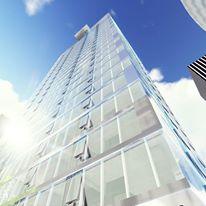NOTEBOOK: Doubts about TIF

KENT DARR Oct 5, 2016 | 9:49 pm
3 min read time
716 wordsBusiness Record Insider, The Insider Notebook
There’s little question that a 26-story, $80 million high-rise apartment building proposed for downtown Des Moines is grabbing attention.
Its 276 luxury apartments will bring residents to a stretch of Walnut Street that for now falls in the shadows of office buildings. For now, it is a quiet stretch after those office workers go home.
The building will provide public spaces and multiple skywalk connections, and it will take a shot at the way we move about by offering electric cars for rent by the public and tenants, meaning that you could live downtown and never worry about owning a vehicle.
What the building won’t do is pay for itself without some tax incentives, at least not to the point that satisfies city economic development specialists.
The city wants to make certain that owners have enough money on hand to make their debt payments and maintain all of the amenities promised by the project. That return should be in the range of 12 to 16 percent, Rita Conner of the city’s economic development department told the city’s Urban Design Review Board on Tuesday. Among other things, the board recommends whether the city should provide financial assistance to projects that request it.
To reach that return on investment target, city staff proposed a tax increment financing package of slightly more than $4.2 million that would be paid out over 10 years after the project exhausts a 10-year, 100 percent abatement of property taxes. That abatement goes to any development project in the downtown area; as a result, it often is called the “birthright” incentive. In the case of 701 Walnut, the abatement will at least equal if not exceed the value of the TIF.
These incentive packages for downtown development frequently receive a quick nod from the Urban Design Review Board and ultimately from the City Council. In the case of 701 Walnut, the Council has approved the preliminary terms of the development package.
But, this go-round, board member Colleen MacRae said, “Wait a minute.” Her objection Tuesday, and in the past, has been that public financing has become a fixture for downtown projects.
“I don’t see the final development agreements, the terms that are critical to the city’s financial obligation,” MacRae said today. “The development agreements explain the city obligation. When you look at what’s going to happen in 10 years or in 20 years, those are critical concerns.”
After raising her concerns, MacRae voted along with the entire board to back the economic development agreement.
She raised a point that was not lost on Blackbird partner Justin Doyle. He too has been a critic of providing financial incentives for just any project proposed for downtown.
However, Doyle, along with other members of the board, points out that 701 Walnut is unique and complicated. Those skywalk connections don’t just appear out of thin air, for one thing. The city is requiring developers to keep one lane of travel open on Walnut Street. Developers typically want to close the entire street during various phases of a project.
And, as board member and downtown developer Tim Rypma pointed out, this is a quality project that could spark additional development on the west side of downtown.
Rypma crunched some numbers during the meeting and determined that construction costs would be around $260 per square foot on a building that will be all glass and steel and concrete.
“This building is going to be truly a 100-year building,” he said. “Someday, our descendants will renovate that building.”
Rypma pointed out that city incentives triggered the development boom of the East Village.
“Without city assistance, Des Moines is not able to build these types of buildings. The numbers just don’t work,” he said.
It is worth noting that Blackbird has attracted nearly $25 million in equity funding from CA Ventures, the Chicago development and investment firm that has sought an entree to the downtown development market.
The company also is backing a $100 million high-rise in Iowa City that is being built without public financing.
Doyle said one reason is that developers in Iowa City are able to generate better returns for investors because the area has surpassed the $2 per square foot threshold that is considered essential for upscale projects.
“Des Moines is hardly at that level,” he said.








